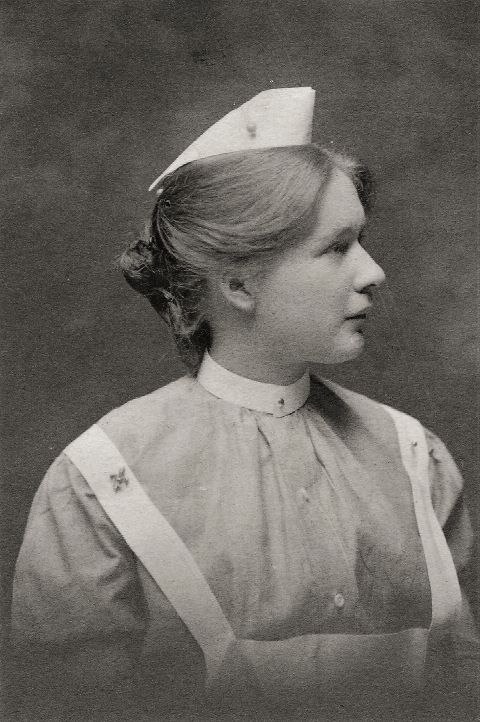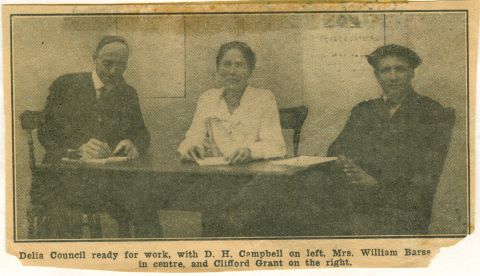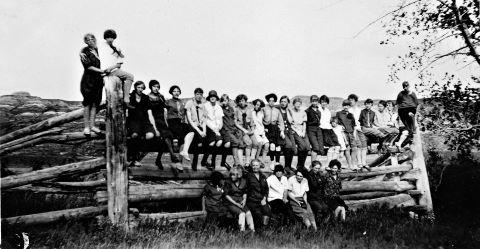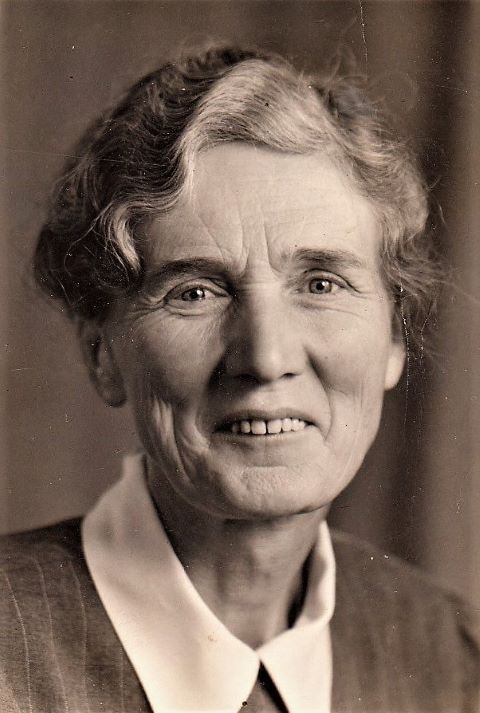Profiles of Alberta Women
Violet McCully Barss

Violet McCully, Graduation Photo from Allegheny General Hospital School of Nursing, Pittsburgh, ca. 1908. Photo courtesy of the Violet McCully Barss Collection, Delia & District Dawson Historical Museum, Delia, Alberta (hereafter Delia Museum).
Profile1
Personal Life and Education
Violet McCully Barss was born Violet Kells McCully to John Henry and Sarah McCully in St. Marys, Ontario in 1885. She was the eldest of four children. Violet attended elementary school at a small rural school nearby St. Marys and completed high school at Pickering College.2 She attended the Toronto School of Domestic Science and in 1902 was certified as a teacher in Domestic Science.3 She then trained in nursing at the Allegheny General Hospital School of Nursing in Pittsburgh, Pennsylvania from 1905-1908 where she studied under a noted obstetrics professor at the University of Pittsburgh.4 After working as a nurse for a few years in the United States, Violet was certified as a registered nurse (R.N.) and moved to High River, Alberta to work as the superintendent of the private maternity hospital there in 1911.5
The next year in 1912, Violet left her position at the maternity hospital and moved to Delia, Alberta (then called Highland) to assist her brother, A. C. “Campbell” McCully, establish his homestead. It was here Violet met her brother’s neighbour, William “Billy” Barss. Violet and William married on 13 October 1913.6 William proved up on his quarter section but ceased to farm after, instead choosing to ply his trade as a carpenter. The two never had children of their own, but were actively involved with the children of the community and were fondly referred to as Aunt Vi and Uncle Billy.7
Political Career
The recent win of franchise for most women in Albert in 1916 and federally in 1918 spurred Violet’s fellow community members to nominate and elect her to Delia Village Council in December 1919.8 The Delia Women’s Institute (WI) proposed Violet as a candidate for village council at its 24 November 1919 Delia WI. She initially “demurred” the nomination but Delia WI members believed her “eminently suited” to the work and she later accepted the nomination.9 Violet was elected to village council for 1920 with 53 votes alongside two men and through an internal council process was selected to serve as reeve (municipal leader) at a meeting in early 1920.10 “Some of the ladies were so exuberant,” the local newspaper recorded, “that they staged a procession through the streets at night.”11 She is believed to be the first woman to lead a municipality in Canada.12 At the time Violet was reeve, Delia hosted 400 inhabitants.13 In 1921 she was again selected as reeve through the process of acclamation.14
As reeve, Violet was involved in the construction of the Delia curling rink in an effort to “offer good clean sport to the young, as well as to the old people of the town, as well as the community.”15 She also updated sanitary laws and had them enforced by a health officer. Her colleague on village council, D. R. “Dunc” Campbell, asserted “sanitary and health conditions in the town showed a marked improvement since Mrs. Barss’ assumption of office.”16 In 1928, six years after Violet was reeve, Delia was still being “recognized as one of the cleanest little towns in the west.”17 Her education as a trained nurse and her experience in women’s organizations prior to 1919 well prepared her for political service. Violet’s tenure as reeve of Delia was well-regarded by Delia and area residents, with her male village council colleague, Clifford Grant, asserting that “No male could have filled her office better – she has filled the bill in every respect.”18

Portrait of Violet McCully Barss, ca. 1920s. Photo courtesy of McCully Barss Collection, Delia Museum.

Picture of Violet McCully Barss with her village council colleagues. Steina J. Sommerville, “Women in Municipal Work: Serving on Councils Women are Credited with Rendering Valuable Service,” Grain Growers Guide, Winnipeg, Manitoba, 14 December 1921, McCully Barss Collection.
“A pioneer in any field is always interesting, but a pioneer woman-reeve of the splendid type of woman Mrs. Barss represents reflects credit on the entire womanhood of Canada. She has the right idea that the franchise is a trust as well as a right, and she lives up to her convictions. … Mrs. Barss is affable and easy of approach. She is a gifted speaker, a clear thinker, and on the platform has the precious faculty of being able to carry the minutest details in her mind and call them forth at the right moment. She is logical in her deductions, has a good grasp of things technical and pertaining to finance, and commands respect and dignified treatment wherever she appears. Under no circumstances could she be flustered into making snap judgements of acting hastily in the discharge of her duty. She evidently has an excellent mind: it is well trained and she applies it.”19
Women’s Organizing and Volunteer Service Within and Beyond the Delia Community
Violet was extensively involved in the Delia community soon after her arrival in 1912, particularly in women’s organizing, church work, children’s groups, and the Canadian Red Cross Society. Violet was a founding member of the Delia WI (est. 1915). She served as the president of the local branch in 1918 and 1919. With Violet at the helm, the Delia WI prioritized local projects including establishing scholarships and supporting local children’s education.20 Though WIs were technically meant to be apolitical, as they accepted provincial government funding, the Delia WI discussed and moved on explicitly political issues like liquor laws. The local branch also hosted Nellie McClung (one of Canada’s Famous Five suffragists) multiple times during the 1920s to speak on provincial legislation regarding women’s causes, as well as transportation and natural resource development. Violet actively crafted the Delia WI into “a more efficient organism for the development of the individual member.”21 It was important to her that women had the opportunity to learn the practicalities of administration and organization. These were skills that Violet consciously sought out for herself and desired for her fellow women members.
In addition to serving as president and various other positions in Delia’s local WI branch, Violet also served as the constituency convenor of the Hand Hills Constituency from 1920 to 1925.22 At the 1923 annual Hand Hills WI Conference, she “was again the unanimous choice of the Hand Hills for Women’s Institute constituency convenor,” indicating that over 100 women in attendance from the constituency showed great faith in her as their leader.23 In this role, Violet organized approximately 12 local branches.

Violet McCully Barss, Hand Hills Constituency, Delia WI Convenor, (standing in row 3 ½ from the front & 3rd from the right, to the left of woman in the dark broad brim hat). Federated Women's Institute of Canada group, Edmonton, Alberta.", 1921-06-23, (CU154541) by McDermid Studio. Courtesy of Glenbow Library and Archives Collection, Libraries and Cultural Resources Digital Collections, University of Calgary.
Violet’s church work constituted a lifelong commitment. She became an active member of the Women’s Missionary Society (WMS) of Delia (est. 1918) and the Delia United Church Ladies’ Aid Society (est. 1917) in 1919. The Delia WMS supported local missionary efforts on First Nation reserves in Alberta and abroad in India and Korea. She served as president of the WMS from 1934 to 1942, as Vice-President in 1926 and 1927, and as Secretary-Treasurer in 1945.24 She also served as a representative of Delia at the Drumheller Presbyterial WMS which, similar to the Hand Hills Constituency, brought local WMSs together to coordinate their efforts. In 1943 she was awarded a Life Membership “in appreciation of her service.”25 In 1968 she was again celebrated by the WMS for 50 years of service, with the dedication noting her fastidious attendance and consistent willingness to make coffee for the group.26 Violet served on various committees in the Ladies Aid but dropped her membership during the mid 1920s to participate more fully in the WMS. She rejoined the group in 1946 and took an active role again in 1957. The Ladies’ Aid fundraised to provide for a variety of charitable causes in Delia and throughout the province, including the local rest room, scholarships for girls to attend the Olds Agricultural College, the Delia Cemetery Committee, and the Pew Fund at the United Church.
In her voluntary service with the Delia WI, Ladies Aid, and WMS, Violet took on roles of Strangers’ Secretary and with the Flower Committee, positions which afforded her the opportunity to check in on new or ill community members and build a sense of community, a cause that was important to her.
Violet was also actively involved in Delia’s Red Cross Society during both the First and Second World Wars, collecting materials to be shipped overseas and running first aid classes in Delia.
In addition to being involved in women’s groups and church organizations, Violet was a leader of girls’ clubs including the Women’s Institute Girls’ Clubs (WIGC) and the Canadian Girls in Training (CGIT) during the 1920s and 30s. These groups were organized to help develop leadership skills in girls, make religious activities fun and accessible, and support childhood education. As a trained nurse, Violet was a professional woman that local girls could aspire to be. She often served as nurse at the WIGC and CGIT camps that were held over the summers.

WIGC Summer Camp – Violet Barss (From Row, 2nd from right, Munson Ferry, Red Deer River, AB, ca. 1926-1927. Photo courtesy of the Violet McCully Barss Collection, Delia Museum.
In addition to her service to the local Delia WI, she volunteered at the provincial level, where she served as the Alberta WI Committee Convenor for Immigration from 1923-1928. In this role, Violet wanted to welcome new immigrants to the Canadian prairies hospitably – she disagreed with nativist attitudes that were common at the time that some immigrants weren’t the “right” type of immigrant to settle in the Canadian prairies. She also served on the Minister of Agriculture’s Advisory Board for the Immigration of Women. This advisory board worked to communicate and coordinate with existing women’s organizations to alert local branches to “the arrival of girls and of women with families to their districts” and ask those branches “to welcome them and keep in touch with them until they ‘find themselves’ and no longer feel [like] strangers in a strange land.”27
Violet also served as a member of the Board of Governors at the University of Alberta from 1923 to 1940. In the early years of the University of Alberta, the Alberta Government asked for representatives from important women’s organizations to serve on the board, and she served as the representative for the Alberta WI. Over the almost twenty years that Violet served on the board of governors, she oversaw major growth at the University of Alberta, including the acquisition of historical collections for the University’s museums, better connection between the University and the cities of Edmonton and Strathcona, and the purchase of land to expand the University Farm. She was one of a handful of members who made decisions about the non-academic operations of the University of Alberta.28
Nursing Career
Though Violet’s formal, paid nursing career ended upon her departure from High River in 1912, she pursued an informal nursing practice in Delia and area that lasted over half a century. Because McCully Barss did not drive, she relied on community members to pick her up and drive her to attend patients in the Delia district. Violet also did not charge for her medical services, possibly because she was no longer registered as a nurse after she married. She provided midwifery, public health, emergency, and palliative care services throughout the entirety of her residence in Delia. Some Delia residents even named their children Violet in respect to Delia’s resident nurse who delivered them. Her over fifty years of service demonstrated her dedication to tending to the needs of her local community, a theme that characterized the majority of Violet’s life work. Her authority as a trained nurse, in addition to her untiring dedication to providing medical services to the community, endeared her to her fellow community members and solidified her reputation as trustworthy and well-respected. A community member described Violet as “Delia’s Florence Nightingale.”29
Violet was known as a generous health care provider, but she was also well known for giving a “wicked needle” and expecting her patients to grin and bear it. In an interview with the Delia Historical Society, Malcolm “Mac” Sinclair, neighbour to Violet in the 1930s, said he “used to accuse her of aiming that needle like she was throwing darts.”30 Along with her reputation for giving a wicked needle, she also had a reputation for being a stern and no-nonsense nurse. All those interviewed by the Delia Historical Society remembered calling her “Mrs. Barss” and nothing else, as a sign of respect.
Community Elder
As Violet aged and as Delia became better connected to larger towns like Hanna and Drumheller with hospitals and other medical services, her community nursing practice scaled-down, but she still attended patients when they called on her and provided them will medical advice or shots of penicillin. She remained active in many of the organizations she had been prior to the Second World War, but no longer took on executive or leadership roles. In her later years, Violet took on the role of well-loved community elder who was celebrated at WI Grandmothers’ Teas and was invited in 1964 to lead the Delia Jubilee Parade. Violet was also invited to the bridal showers of many of the women who grew up with her as nurse and WIGC and CGIT leader, where she presented them with handmade corsages from her own garden. In her interview with the Delia Historical Society, Gloria Johnson reminisced: “You know, she was at every girl’s shower because of course she knew us all.” When asked about her corsage, Johnson said that she was “positive it was a red geranium.”31

Violet McCully Barss, ca. 1960. Photo courtesy of the Violet McCully Barss Collection, Delia Museum.
Following almost 60 years of service to the Delia area, Violet McCully Barss passed away 11 September 1971.
Read More About Violet McCully Barss
Footnotes
1 This research was conducted by Emily B. Kaliel and the Delia Historical Society (which owns and operates the Delia Museum, Delia, Alberta). This research was funded in part by the Alberta Government, Heritage Preservation Partnership Program.
2 ”Announcement of Pickering College For the Year 1900-1901,“ (Toronto: The Bryant Press, 1900), accessed May 11, 2022, https://archive.org/details/announcementof190001pick/page/n1/mode/2up?view=theater; Alice Harris to Violet McCully Barss, 1 October 1900, correspondence, in email from Al McCully to author (Emily B. Kaliel), 4 March 2022.
3 Toronto School of Domestic Science Certificate, Item 001, Violet McCully Barss Collection, Delia Museum, Delia, Alberta (hereafter McCully Barss Collection).
4 Trained Nursing Certificate, Item 027, McCully Barss Collection.
5 Registered Nursing Certificate, Item 026, McCully Barss Collection; Newspaper clipping from Violet McCully Barss‘s scrapbook, in email from Al McCully to author, 9 January 2022.
6 "Wedding Bells: Barss-McCully," The Hanna Herald, Hanna, Alberta, 27 November 1913.
7 Jack McCully, ”Billy and Violet Barss,“ in The Delia Craigmyle Saga, ed. Lester Battle (Lethbridge, Alberta: Southern Printing Company Limited, 1970), 162-163.
8 While women‘s suffrage was won in Alberta in 1916, it should be noted that not all women were included. Chinese and Japanese women were excluded until the 1940s, and First Nations women were not granted the right to vote until 1965.
9 "Election of Officers Womens Institute," The Delia Times, Delia, Alberta, 4 December 1919, McCully Barss Collection.
10 ”Village Council Elected for 1920,“ The Delia Times, 11 December 1919, McCully Barss Collection.
11 ”What Munson Thinks,“ The Delia Times, 25 December 1919, McCully Barss Collection.
12 Steina J. Sommerville, ”Women in Municipal Work: Serving on Councils Women are Credited with Rendering Valuable Service,“ The Grain Growers Guide, Winnipeg, MB, 14 December 1921, McCully Barss Collection. Others have claimed the same for McCully Barss, including ”Appointed to the Board of Governors Alberta University,“ The Hanna Herald, 25 October 1923; ”City Glances: Delia Once Had Lady Major,“ Lethbridge Herald, Lethbridge, AB, 15 February 1939; The Delia-Craigmyle Saga (Lethbridge, Alberta: Southern Printing Company Limited, 1970), 161-165; Kay Sanderson, 200 Remarkable Alberta Women (Calgary: Famous Five Foundation, 1999), 40; ”Delia honours Canada‘s first female municipal leader,“ The Drumheller Mail 3 October 2018, accessed 2 May 2022, https://www.drumhellermail.com/news/31220-delia-honours-canada-s-first-female-municipal-leader; Jacqueline Gold-Irwin, ”Delia honours first female mayor,“ The Hanna Herald 7 October 2018, accessed 2 May 2022, https://www.hannaherald.com/news/local-news/delia-honours-first-female-mayor.
13 Sommerville, ”Women in Municipal Work,“ McCully Barss Collection.
14 "Village Council in by Acclamation," The Delia Times, 9 December 1920, McCully Barss Collection.
15 Letter from Violet McCully Barss, Delia, to the Deputy Minister of Municipal Affairs, Edmonton, Alberta, 27 September 1921. GR1974.074, file 1263ai, Provincial Archives of Alberta, Edmonton, Alberta (hereafter PAA).
16 Sommerville, ”Women in Municipal Work,“ McCully Barss Collection.
17 ”Toilets and Typhoid,“ The Delia Times, 26 July 1928.
18 Sommerville, ”Women in Municipal Work,“ McCully Barss Collection.
19 Sommerville, ”Women in Municipal Work,“ McCully Barss Collection.
20 For example, see ”Women‘s Institute Meet in Regular Confab,“ The Delia Times, 4 September 1919, McCully Barss Collection; ”Women‘s Institute to Entertain Teachers,“ The Delia Times, 2 October 1919, McCully Barss Collection.
21 Sommerville, ”Women in Municipal Work,“ McCully Barss Collection
22 Sommerville, ”Women in Municipal Work,“ McCully Barss Collection; "Women's Institute," The Hanna Herald, 26 May 1921; Mrs. J. F. Price, "Alberta Women's Institute News," The Lethbridge Herald, 30 October 1926.
23 Special Correspondent, ”Imperial Oil Fire at Mecheche,“ The Hanna Herald 8 November 1923, 1.
24 ”Delia Women‘s Missionary Society,“ The Delia Times, 31 March 1927; ”Women‘s Missionary Society,“ The Delia Times, 8 February 1945; ”Local and District,“ The Delia Times, 20 December 1928; ”Dedication to Mrs. Macpherson & Mrs. Barss, 1968,“ shared by Al McCully with author via email, 4 March 2022.
25 ”Dedication to Mrs. Macpherson & Mrs. Barss, 1968.“
26 In 1962, the Delia WMS and the Ladies Aid (which had changed its name to the Women‘s Association in 1953) joined together to become the United Church Women (UCW).
27 ”Advisory Board for Immigration of Women Organized: Local Councils Will Be Asked to Assist in Cities—Miss MacMillan is Chairman,“ The Lethbridge Daily Herald, 11 April 1924.
28 "4 New Members Named to Board Varsity Governors: H. H. Parlee Succeeds Chief Justice Harvey After 23 Years as Chairman," Lethbridge Herald, 18 October 1940, McCully Barss Collection.
29 Mac and Jeanne Sinclair, interview with Carol Sisley, Delia History Society, 21 August 2021, transcript, interview and transcript can be found in the McCully Barss Collection.
30 Mac and Jeanne Sinclair, interview, 21 August 2021, transcript, McCully Barss Collection.
31 Gloria and Keith Johnson, interview with Pat Hoover, Delia Historical Society, 24 August 2021, transcript, McCully Barss Collection.
Student & Academic Services for The Alberta Women's Memory Project - Last Updated June 29, 2023


